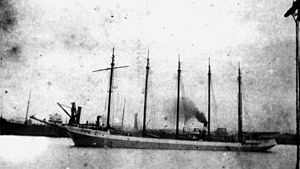Malahat (schooner)
 |
|
| History | |
|---|---|
|
|
|
| Owner: | Archibald McGillis, Vancouver, 1923; General Navigation Co., Vancouver, 1929; Gordon Gibson, Sr., 1934; Canada West Coast Navigation Company |
| Builder: | Cameron Genoa Mills Shipbuilders Ltd., Victoria, BC |
| Cost: | $750,000 Canadian |
| Launched: | 1917 |
| Out of service: | 1944 |
| General characteristics | |
| Class and type: | Mabel Brown class |
| Tonnage: | 1,544 grt, 1199 net |
| Length: | 246 ft. |
| Beam: | 43 ft. 9 in. |
| Depth: | 21 ft. |
| Propulsion: | Twin Bolinder semi-diesels, 320 B.H.P.; coal-fired steam boiler |
| Sail plan: | Five-masted schooner |
| Complement: | Minimum of 15 crew members |
| Notes: | Hull of Douglas fir. Top speed (est.) 5 knots. Infamous rum-runner that eluded US Coast Guard for 13 yrs. |
Malahat, a large 5-masted lumber schooner from Vancouver, BC, was known as "the Queen of Rum Row" in her day. She became famous (or ) for rum-running on the US Pacific Coast between 1920 and 1933. The Vancouver Maritime Museum says that Malahat delivered "more contraband liquor than any other ship."
Malahat was built in 1917 in Victoria, British Columbia, by Cameron Genoa Mills Shipbuilders. Her owner was the Canadian Steamships Company of Montreal. As a result of the "ship emergency" during World War I, Malahat was pressed into service even before her engines were installed. She "performed reasonably well under sail" during her first voyage.
Malahat was comfortably equipped for long voyages as of 1934, with "a coal-burning fireplace in the owner's quarters and two full-size bathtubs."
Active until 1944, the Mabel Brown class Malahat was the longest lived of all the 12 five-masted auxiliary schooners built in Victoria and North Vancouver in 1917–1918.
The Malahat was owned by the Riefel family of Vancouver, a family involved in the local brewing industry. The Malahat sailed out to "Rum Row", located somewhere between the Pacific Coast and Hawaii (possibly the Farallon Islands), where she served as a floating warehouse while smaller, faster vessels picked up the contraband liquor and ran it ashore. The bottles were offloaded in cases or in burlap bags holding 12 bottles apiece. Some of the fast "mosquito boats" were equipped with Liberty engines, and could reach speeds of 25 knots. Estimates of the top speed of these smaller vessels range as high as 35–40 knots. The Malahat was not very fast; one source claims that she could do "about five knots!"
Jim Stone, son of Malahat's Captain Stuart Stone, interviewed family and acquaintances to learn more about his father's activities during the Prohibition Era (1920–1933). In his book, My Dad, The Rum Runner, Stone determined that the Malahat could carry up to 100,000 bottles of illegal liquor, of which 40,000 were stowed on deck. Another source cites a figure of "84,000 cases in the hold plus approximately 16,000 on deck when the Ryuo II loaded from her, summer 1933." One cargo, consisting of "32,000 cases of whiskey and 15 barrels of beer," required "almost nine months to discharge" due to the foggy weather in 1925 along the California coast. Gibbs estimates that the ship delivered 120,000 cases annually, "even when the trade was slow," making one or two trips per year.
...
Wikipedia
